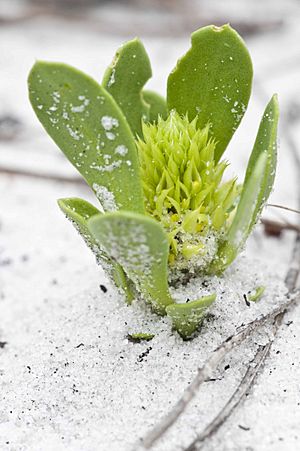Tiny polygala facts for kids
Quick facts for kids Tiny polygala |
|
|---|---|
 |
|
| Conservation status | |
| Scientific classification | |
| Genus: |
Polygala
|
| Species: |
smallii
|
Polygala smallii is a very rare flowering plant. People often call it the tiny polygala or tiny milkwort. It belongs to the milkwort family. This plant is special because it only grows in one place: the southeastern coast of Florida in the United States.
Today, we only know of eight places where this plant still lives. Most of these tiny plants are found in just one spot in Miami-Dade County. Sadly, Polygala smallii is an endangered species in the United States. This means it is at high risk of disappearing forever. Its biggest threat is losing the places where it lives.
Contents
What is Tiny Polygala?
This plant is a small, short-lived herb. It grows from a main root called a taproot. The plant usually reaches about 2 to 4 centimeters tall. That's about the size of a small LEGO brick!
Its leaves are shaped like a spatula. They grow in a tight circle at the bottom of the plant. These leaves can be up to 3.5 centimeters long. At the top of each stem, you'll find a small cluster of yellow-green flowers. This flower cluster often stays shorter than the leaves.
Life Cycle of the Tiny Polygala
The tiny polygala lives above ground for about 180 days. After this time, it seems to disappear. But it's not gone forever! It waits underground until the next wildfire happens in its area. Fire is a very important part of its life cycle.
Where Does It Live?
This special plant grows in certain habitats in Florida. These include Florida scrub and pine rockland areas. You can find it in Miami-Dade, Palm Beach, St. Lucie, and Martin Counties.
One large group of these plants lives on public land near Zoo Miami. It also grows on land used by the United States Coast Guard. About 10,000 plants have been counted at the Coast Guard site. This is the biggest known group of tiny polygala plants. It has also been seen at the Fort Lauderdale Executive Airport. There, it lives in a special protected area for the gopher tortoise.
Because of its unique life cycle, the plant might be present in places where it hasn't been seen recently. It can stay hidden underground for a while.
Why Is It Endangered?
The places where tiny polygala lives need natural fires to stay healthy. Fire helps this plant in many ways. It clears away other plants that compete for sunlight and space. The tiny polygala needs open, sunny spots to grow well. It can even grow back easily after a wildfire.
Sometimes, even hurricanes have helped the plant. The storms can create open spaces in the habitat.
The Problem with Fire Suppression
For a long time, people have stopped natural fires in Florida. This is called fire suppression. When fires are stopped, the plant's habitat becomes overgrown. Large, woody plants take over. This blocks the sunlight the tiny polygala needs.
To help the plant, we need to bring fire back. This is done through planned fires called prescribed burns. These controlled fires help open up the overgrown areas.
Fire and Seed Germination
Fire is also important because it helps the plant's seeds grow. Studies have shown that seeds exposed to smoke are much more likely to sprout. They also sprout faster! The seeds can wait in the ground, forming a "soil seed bank". They stay there until smoke tells them it's time to grow.
Habitat Loss
Another big threat to the tiny polygala is losing its habitat completely. Land is often cleared for new homes and businesses. This destroys the special places where this rare plant can live. Protecting these areas is very important for its survival.


